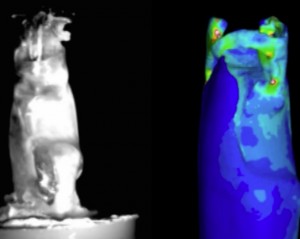Prime-time punch

University of Massachusetts Amherst researchers are using X-ray scans and computational models to learn the secrets of mantis shrimp, crustaceans who fire their appendages with amazing speed and force to ward off enemies and capture prey. On the left is a freeze frame from a high-speed video of an experiment in which a materials-testing machine compresses a mantis shrimp appendage to mimic the way the crustacean would prepare to strike. On the right is a finite element computer model of the appendage under similar loading conditions. Blue, or cold, regions represent areas with low calculated strain energy density. Red, or hot, regions have high calculated strain energy density. The comparisons show the model’s predicted behavior resembles the appendage’s physical behavior. (Images: Michael Rosario, University of Massachusetts Amherst. A video, “An inside look at the mantis shrimp’s punching mechanism,” is available in the Related Links box at right.)
An archery avocation got Michael Rosario thinking seriously about killer shrimp.
As an undergraduate integrative biology student at the University of California, Berkeley, Rosario co-founded an archery club. As he won competitions, he also studied with Sheila Patek, an evolutionary biology, biomechanics and animal behavior researcher. The intersection of the two interests has led Rosario, a Department of Energy Computational Science Graduate Fellowship (DOE CSGF) recipient, to apply computers to crustaceans and to a featured role on a National Geographic television program.
Rosario and Patek focus on the mantis shrimp, a group of around 400 species named for their resemblance to true shrimp and to the praying mantis, the garden insect hunter. These denizens of the ocean floor and coral reefs deliver powerful, lightning-fast blows. Their club-like appendages, which also can open to deploy needle-sharp claws, reach top speeds of around 50 miles per hour in less than 3 milliseconds. That’s so powerful the claws pull water molecules away from each other to form a cavitation bubble that delivers an additional shock, emits sound waves and a spark of light, and creates a temperature spike of up to 7,000 degrees centigrade – about as hot as the sun’s surface.
What’s more, a mantis shrimp appendage delivers a blow measured at up to 300 pounds, thousands of times the creature’s body weight. It’s one of the highest peak forces any animal produces.
“I kept looking at this animal and trying to figure out its relationship to how I knew bows and arrows work,” Rosario says. Shrimp claws and bows both store muscle power gradually and release it in a burst. But while each of a modern bow’s parts has a specific duty – acting as a brace or storing elastic energy – “when you look at a mantis shrimp appendage, it’s just the exoskeleton. It’s one structure that has to deal with these competing demands.”
As an undergraduate, Rosario largely focused on experiments testing the exoskeletons of mantis shrimp appendages. By using wire to replace the muscle that loads the appendage’s spring, he could measure the amount of force required as a function of displacement in the claw over time. Rosario found it took 40 to 50 Newtons to fully compress it – or the force necessary to lift between 9 and 11 pounds. “I couldn’t close the appendage with my hands.”
Rosario felt stifled by the experiment’s limitations. “What I was really interested in was elastic energy” – the potential energy stored in a crumpled or stretched or otherwise deformed bendable object, like a retracted bowstring. “There’s no good way to measure elastic energy in these systems.” He wanted to know how a mantis shrimp appendage, as a single structure, handled demands that usually require specialized structures.
Rosario joined Patek as a graduate student after she moved her lab to the University of Massachusetts Amherst. Computational models were the key, he decided, to discovering the mantis shrimp’s elastic energy secrets. In an intensive summer course he participated in Biomesh, a finite element analysis (FEA) workshop that Elizabeth Dumont, another UMass biology professor, had helped create. FEA, more typically used in engineering applications, decomposes a model into a series of simple digital bricks, Rosario says, then computes the physical properties and changes in each. Starting with computer tomography (CT) scans of mantis shrimp appendages, he created models to calculate what parts of the appendage bear the load when it’s compressed to strike – in essence, how and where it stores elastic energy.




